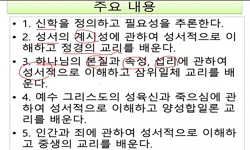“하나님”과 “하느님” 논쟁이 교파들의 관습적 의례에 기초한 영토분할 방식으로 정리됨으로 개신교단 다수는 “하나님” 사용을 공식화했다. 본고는 그 같은 정치적 접근이 충분한 해...
http://chineseinput.net/에서 pinyin(병음)방식으로 중국어를 변환할 수 있습니다.
변환된 중국어를 복사하여 사용하시면 됩니다.
- 中文 을 입력하시려면 zhongwen을 입력하시고 space를누르시면됩니다.
- 北京 을 입력하시려면 beijing을 입력하시고 space를 누르시면 됩니다.
https://www.riss.kr/link?id=A102123670
-
저자
한재동 (나사렛대학교)

- 발행기관
- 학술지명
- 권호사항
-
발행연도
2016
-
작성언어
Korean
-
주제어
하나님 ; 하느님 ; 예배대상 ; 신명호칭 ; 예배언어 ; 유비 ; 은유 ; Hananim ; Haneunim ; Worship Object ; Divine Name ; Liturgical Language ; Analogy ; Metaphor
-
등재정보
KCI등재
-
자료형태
학술저널
-
수록면
7-38(32쪽)
-
KCI 피인용횟수
0
- 제공처
- 소장기관
-
0
상세조회 -
0
다운로드
부가정보
국문 초록 (Abstract)
“하나님”과 “하느님” 논쟁이 교파들의 관습적 의례에 기초한 영토분할 방식으로 정리됨으로 개신교단 다수는 “하나님” 사용을 공식화했다. 본고는 그 같은 정치적 접근이 충분한 해결책이 될 수 없다는 입장에서 재검토의 필요를 제기한다. 호칭이 교파표시의 용도가 된 정치적 분할방식은 거듭 분할문제를 야기한다. 또 영토분할 접근은 적대전선을 만들어 갈등을 유발하고 이에 대응하는 한국적 종교 혼합주의의 원인이 된다. 무엇보다 영토분할 방식은 교회의 실체인 예배회중에 미치는 영향을 고려하지 않은 점에서 문제를 갖는다. 이 같은 가정으로부터 본고는 “하나님”과 “하느님” 논쟁의 실천신학적 재검토를 도모한다. 이전 논쟁들이 호응을 얻지 못한 이유의 하나가 이론적 측면에만 초점을 두었기 때문이기도 하거니와 논쟁의 핵심은 호칭이 예배회중의 경험에 미치는 영향에 있다고 판단하기 때문이다. 예배회중의 경험과 이해라는 관점에서 본고는 “하나님” 호칭의 한계와 함께 “하느님” 사용의 정당성을 논증한다. “하나님”과 “하느님”은 그 개념적 의도인 “예배대상”을 중심으로 분석할 때 그 기본적 기능과 한계가 드러난다. “하나님”과 “하느님”은 성경적 예배대상의 고유호칭에 해당치 않아 신성 일반을 지칭하는 보통명사이어야 하지만 한국적 특수성에 의해 고유명사에 준하는 신성성을 부여받게 됨으로 다른 문화권의 신명 호칭에서 볼 수 없는 특별한 영향을 예배회중에 미친다는 사실이 본고논의의 바탕이다. 이에 성경적 신명의 하향식 유비성과 상향식 은유성에 비춰 “하나님”의 추상성과 “하느님”의 구상성이 갖는 영향의 명암을 비교할 때 “하느님” 호칭이 예배회중에게 보다 전인적이고 긍정적인 영향을 미칠 수 있다는 결론에 도달한다. 반론을 피하기 위해 본고는 “하느님”의 전인적이고 긍정적인 영향이 성경적 신명체계에 비춰 정당함을 보인다. 나아가 신명 호칭의 변개가 가져올 수 있는 의례적 안정의 손상 부담에도 불구하고 본고는 종교와 믿음의 또 다른 축인 자극과 각성의 중요성에 주의를 환기하며 이를 위한 의례의 갱신과 개혁의 중심에 언어 문제가 있음을 보여준다. 또한 이와 연계하여 예배회중의 자세에 초점을 두는 성경적 예배 이해(언어)에도 “하느님” 호칭이 더 적합함을 보여준다.
다국어 초록 (Multilingual Abstract)
The majority of Korean protestant denominations have officially adopted the use of “Hananim,” as the controversy on “Hananim” and “Haneunim” was settled in terms of a territory division policy, following the ritualistic custom of each deno...
The majority of Korean protestant denominations have officially adopted the use of “Hananim,” as the controversy on “Hananim” and “Haneunim” was settled in terms of a territory division policy, following the ritualistic custom of each denomination. The article suggests a reexamination of that controversy, claiming that such a political approach is not a sufficient resolution. The method of political division, by which the divine appellations come to be used as a designation of denominational belongings, brings about further matter of political division. The territory division approach also causes the Korean sort of religious synthesism by way of making hostile fronts inducing unnecessary conflicts. Above all, that way is problematic in that it does not consider the influences that such appellations could have on the liturgical congregation. From the above assumptions, the article attempts to reexamine the controversy on “Hananim” and “Haneunim” in terms of practical theology. The author judges not only that the previous arguments do not get due attention because of their focus on theoretical aspects, but also that the core matter of the controversy is the influence of the appellation on the liturgical congregation. The study argues for the legitimacy of the use of “Haneunim,” while pointing out the deficiency of “Hananim.” Both “Hananim” and “Haneunim” expose their functions and limitations as they are analysed in terms of “worship object” as their conceptual intention. The basic presupposition of the discourse is that “Hananim” and “Haneunim” have special influences on the liturgical congregation in Korea that divine appellations of other cultures do not; they must be a common noun designating divinity in general because they do not belong to the proper appellations for the biblical worship object, but they are given a sacredness in accordance with proper names. In this, it follows that “Haneunim” could have more holistic and positive influences on the liturgical congregation, when the abstract “Hananim” and the concrete “Haneunim” are compared in view of the analogical downwardness and the metaphoric upwardness of the biblical divine appellations. To avert objections, the article shows that the holistic and positive influences of “Haneunim” are justified in light of the biblical system of divine names. Furthermore, against the argument that the change of the divine appellation could do harm to the ritual-psychologic stability, the article calls attention to the importance of challenge and awakening as the other axis of religion and faith, and argues that the linguistic matter is placed on the center of ritual renewals and reforms for challenge and awakening. Related to it, the biblical understanding (language) of worship as well is more appropriate to “Haneunim.”
목차 (Table of Contents)
- 초록
- I. 들어가는 말
- II. “하나님”과 “하느님” 명칭의 기능과 한계
- III. “하나님”과 “하느님”의 특수한 맥락과 문제
- IV.“하나님”과 “하느님”이 예배회중에 미치는 영향의 명암
- 초록
- I. 들어가는 말
- II. “하나님”과 “하느님” 명칭의 기능과 한계
- III. “하나님”과 “하느님”의 특수한 맥락과 문제
- IV.“하나님”과 “하느님”이 예배회중에 미치는 영향의 명암
- V. 예배대상 이름으로서“하느님”의 적합성
- VI. 예배대상 이름으로서“하느님”의 형성력
- 참고문헌
- Abstract
참고문헌 (Reference)
1 이익섭, "하느님과 하나님" 31 : 273-280, 1996
2 배현철, "하나님이냐 하느님이냐?" 46 (46): 189-198, 2002
3 김중은, "하나님과 하느님" 79 : 5-8, 2006
4 최태영, "하나님, 하느님 호칭 왜 다른가?: 기독교의 신명고" 144 : 24-37, 2009
5 유응기, "하나님 개념에 관하여: 공동번역 중의 하느님에 대한 시비 양론에 관한 고전 문법적 고찰 중심으로" 38 (38): 40-43, 1971
6 김광식, "하ᄂᆞ님과 ᄒᆞ나님" 27 : 115-130, 1999
7 이정구, "타자(他者)로서 그리스도 몸에 대한 목회학적 이해" 한국실천신학회 (28) : 607-624, 2011
8 안선희, "청년예배 현상에 대한 예배학적 고찰" 한국실천신학회 (30) : 119-139, 2012
9 안성호, "존 로스의 중국유교 원시유일신론과 중국어 성서번역의 용어논쟁에 관한 신학적 입장" 한국기독교역사학회 (40) : 219-238, 2014
10 김병석, "예배의 문화수용에 관한 초월성 연구" 한국실천신학회 (48) : 35-61, 2016
1 이익섭, "하느님과 하나님" 31 : 273-280, 1996
2 배현철, "하나님이냐 하느님이냐?" 46 (46): 189-198, 2002
3 김중은, "하나님과 하느님" 79 : 5-8, 2006
4 최태영, "하나님, 하느님 호칭 왜 다른가?: 기독교의 신명고" 144 : 24-37, 2009
5 유응기, "하나님 개념에 관하여: 공동번역 중의 하느님에 대한 시비 양론에 관한 고전 문법적 고찰 중심으로" 38 (38): 40-43, 1971
6 김광식, "하ᄂᆞ님과 ᄒᆞ나님" 27 : 115-130, 1999
7 이정구, "타자(他者)로서 그리스도 몸에 대한 목회학적 이해" 한국실천신학회 (28) : 607-624, 2011
8 안선희, "청년예배 현상에 대한 예배학적 고찰" 한국실천신학회 (30) : 119-139, 2012
9 안성호, "존 로스의 중국유교 원시유일신론과 중국어 성서번역의 용어논쟁에 관한 신학적 입장" 한국기독교역사학회 (40) : 219-238, 2014
10 김병석, "예배의 문화수용에 관한 초월성 연구" 한국실천신학회 (48) : 35-61, 2016
11 한재동, "신학적 유비(ἀναλογία)와 설교" 한국실천신학회 (32) : 255-306, 2012
12 조기연, "순교자·성자 공경에 대한 한국 개신교회적 이해" 한국실천신학회 (30) : 91-117, 2012
13 황안웅, "말, 글 그리고 세상: 한자의 어원으로 보는 우리말 우리글" 아침이슬 2013
14 김명실, "공동체적 탄원기도로서의 통성기도: 통성기도의 정체성의 정립과 그 신학과 실천의 나아갈 방향 모색" 한국실천신학회 (24) : 299-335, 2010
15 Marion, Jean-Luc, "With a Foreword by David Tracy" University of Chicago 1995
16 Brown, Rick, "Who is ‘Allah’?" 23 (23): 79-86, 2006
17 Austin, J. L, "Urmson and Marina Svisa" Harvard University 1975
18 Derrida, Jacques, "Translated by Gayatri Chakravorty Spivak" Johns Hopkins University 1997
19 Brown, Rick, "Toward Respectful Understanding and Witness among Muslims: Essays in Honor of J. Dudley Woodberry" William Carey Library 147-178, 2012
20 Eichrodt, Walther, "Theology of the Old Testament" Westminster 1961
21 Nida, Eugene A, "The Theory and Practice of Translation" Brill 2003
22 Ricoeur, Paul, "The Rule of Metaphor: Multi-disciplinary Studies of the Creation of Meaning in Language" University of Toronto 1981
23 Lee, Archie C. C, "The Oxford Handbook of Christianity in Asia" Oxford University 121-133, 2014
24 Spangler, Ann, "The Names of God: 52 Bible Studies for Individuals and Groups" Zondervan 2009
25 Hemphill, Ken, "The Names of God" B&H 2001
26 Frankel, Ellen, "The Encyclopedia of Jewish Symbols" Jason Aronson 1995
27 Chauvet, Louis-Marie, "Symbol and Sacrament: Sacramental Reinterpretation of Christian Existence" Liturgical 1995
28 Bell, Catherine, "Ritual: Perspectives and Dimensions" Oxford University 2009
29 Heidegger, Martin, "Poetry, Language, Thought" HarperPerennial 2001
30 Lakoff, George, "Philosophy in the Flesh: the Embodied Mind & its Challenge to Western Thought" Basic 1999
31 McFague, Sallie, "Models of God: Theology for an Ecological, Nuclear Age" Fortress 1987
32 Lakoff, George, "Metaphors We Live" University of Chicago 1980
33 Scholem, Gershom, "Major Trends in Jewish Mysticism" Schocken 1995
34 Vaan, Michiel de, "Leiden Indo-European Etymological Dictionary Series" Brill 2008
35 Kassian, Mary, "Knowing God by Name: A Personal Encounter" LifeWay 2008
36 Bubber, Martin, "I And Thou" Charles Scribner’s Sons 1958
37 Ricoeur, Paul, "Hermeneutics and the Human Sciences: Essays on Language, Action and Interpretation" Cambridge University Press 1981
38 Smith, Mark S, "God in Translation: Deities in Cross-Cultural Discourse in the Biblical World" William B. Eerdmans 2008
39 Geoffrey Wigode, "Encyclopedia of Judaism" New York University 2002
40 McAnnally-Linz, Ryan, "Did Jesus Pray to Allah?" 43 (43): 16-19, 2014
41 Saussure, Ferdinand de, "Course in General Linguistics" Open Court 1983
42 Byrne, Máire, "Christianity, and Islam: A Basis for Interfaith Dialogue" Continuum 2011
43 Heidegger, Martin, "Being and Time" Harper and Row 1962
44 Papanikolaou, Aristotle, "Being With God: Trinity, Apophaticism, and Divine-Human Communion" University of Notre Dame 2006
45 Steiner, George, "After Babel: Aspects of Language and Translation" Oxford University 1998
동일학술지(권/호) 다른 논문
-
- 한국실천신학회
- 안선희
- 2016
- KCI등재
-
기독교 예배 공간에서의 빛의 상징성과 창의력에 대한 연구
- 한국실천신학회
- 전창희
- 2016
- KCI등재
-
- 한국실천신학회
- 박관희
- 2016
- KCI등재
-
초기 한국장로교회 설교학 원리 연구 - Herrick Johnson의 ‘적응의 법’을 중심으로 -
- 한국실천신학회
- 김병석
- 2016
- KCI등재
분석정보
인용정보 인용지수 설명보기
학술지 이력
| 연월일 | 이력구분 | 이력상세 | 등재구분 |
|---|---|---|---|
| 2027 | 평가예정 | 재인증평가 신청대상 (재인증) | |
| 2021-01-01 | 평가 | 등재학술지 유지 (재인증) |  |
| 2018-01-01 | 평가 | 등재학술지 유지 (등재유지) |  |
| 2015-01-01 | 평가 | 등재학술지 유지 (등재유지) |  |
| 2013-01-01 | 평가 | 등재학술지 유지 (등재유지) |  |
| 2010-01-01 | 평가 | 등재학술지 선정 (등재후보2차) |  |
| 2009-01-01 | 평가 | 등재후보 1차 PASS (등재후보1차) |  |
| 2007-01-01 | 평가 | 등재후보학술지 선정 (신규평가) |  |
학술지 인용정보
| 기준연도 | WOS-KCI 통합IF(2년) | KCIF(2년) | KCIF(3년) |
|---|---|---|---|
| 2016 | 1.81 | 1.81 | 1.61 |
| KCIF(4년) | KCIF(5년) | 중심성지수(3년) | 즉시성지수 |
| 1.53 | 1.4 | 0.653 | 0.62 |




 KCI
KCI eArticle
eArticle







